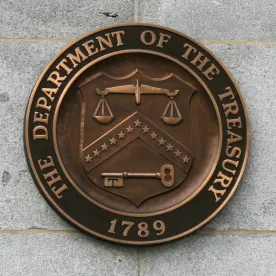On April 23, 2020, the Treasury Department and the Internal Revenue Service (the “IRS”) issued proposed regulations (the “Proposed Regulations”) under Section 512(a)(6) of the Internal Revenue Code (the “Code”). Section 512(a)(6) was enacted as part of the 2017 Tax Cut and Jobs Act (the “TCJA”) and requires exempt organizations (including individual retirement accounts)[1] to calculate unrelated business taxable income (“UBTI”) separately with respect to each of their unrelated trades or businesses, thereby limiting the ability to use losses from one business to offset income or gain from another.
In August 2018, the Treasury Department and the IRS issued Notice 2018-67 (the “Notice”), which provided interim guidance on the application of Section 512(a)(6). We previously discussed the Notice in an earlier post. We recently discussed the Proposed Regulations in a post on our Tax Talks blog; however this post is intended to be geared toward our clients in the private funds industry.
The main takeaways from the Proposed Regulations are that the IRS and Treasury Department have (i) simplified the manner in which exempt organizations classify their various business activities for purposes of determining their UBTI; and (ii) provided some relief and guidance in applying certain aggregation rules, which will help exempt organizations who generally are minority investors in private funds.
Background
Generally, while under Section 512(a)(6) exempt organizations can no longer use losses or expenses from one unrelated trade or business to offset gains or income from another unrelated trade or business, the Proposed Regulations allow an exempt organization to treat unrelated businesses held through multiple partnerships as a single unrelated business, as long as the exempt organization either (1) directly holds no more than 2% of the capital and profits of the applicable partnership or (2) directly (taking into account interests held by certain related persons) holds no more than 20% of the capital of the applicable partnership and does not have “control” over the applicable partnership.
These rules may affect how exempt organizations structure their investments in private funds. For example, an exempt organization may have the incentive to ensure its investment across multiple funds is limited to 2% or less in each fund. For a larger investment, an exempt organization may guide the nature of limited partner consent or approval rights that an investor would otherwise request in order to ensure the control test is met.
The Proposed Regulations will apply to taxable years beginning on or after the date they are published as final; however, exempt organizations may rely on the Proposed Regulations before they are finalized. In addition, until the Proposed Regulations are finalized, exempt organizations may rely on a reasonable, good-faith interpretation of what constitutes a separate trade or business under current law or the methods described in the Notice for aggregating or identifying separate trades or businesses.
Aggregating UBTI from Trades or Businesses
Under Section 512(a)(6), for purposes of calculating UBTI, an exempt organization can only aggregate items of income and deduction if they relate to the same trade or business.
Identification of Trades or Businesses Other Than Investment Activities
Other than with respect to investment activities and income received from controlled entities (discussed below), the Proposed Regulations generally use the two-digit North American Industry Classification System (“NAICS”) sector codes as the primary method of identifying separate trades or businesses, rather than the six-digit codes suggested in the Notice. This reduces the numbers of trades or businesses from over 1,050 under the Notice to twenty under the Proposed Regulations, which will greatly reduce the compliance burden for many exempt organizations, permitting such organizations to aggregate more of their business activities into a single trade or business and enhancing their ability to use losses realized by those business activities.
Investment Activities
Under the Proposed Regulations, all investment activities are treated as a single and separate unrelated trade or business. For this purpose, investment activities are limited to the following three activities only: (i) direct or indirect investments in partnerships designated as “qualifying partnership interests” (“QPIs”), (ii) debt-financed properties, and (iii) qualifying S corporation interests.
Qualifying Partnership Interests
The Proposed Regulations permit, but do not require, an exempt organization to aggregate UBTI realized from all QPIs as a single trade or business in investments; however, once an exempt organization opts to designate a partnership interest as a QPI, the exempt organization cannot use a NAICS two-digit sector code to identify the partnership’s underlying trade or business unless and until the partnership interest is no longer a QPI.
Under the Proposed Regulations, the following investments in partnerships (including limited liability companies and other entities that are classified as partnerships for U.S. federal income tax purposes) may be treated as QPIs, so long as the exempt organization is not the general partner of the partnership:[2] (i) directly-held partnership interests that satisfy the de minimis test, (ii) directly-held partnership interests that satisfy the control test, and (iii) indirectly-held partnership interests identified under the look-through rule (each of which is described below). Consistent with the Notice, the Proposed Regulations permit aggregation of UBTI from certain partnership interests with multiple trades or businesses, including ones conducted by lower-tier partnerships, and any QPIs may be aggregated with all other QPIs and treated as a single trade or business for purposes of Section 512(a)(6)(A).
The benefit of this aggregation rule for an exempt organization investing in private funds is that, for its QPIs, it will be able to aggregate gains and losses from UBTI generating activities conducted by those funds without having to identify each and every underlying activity generating those gains and losses. This saves exempt organizations the administrative burden of obtaining information about the underlying activities of a fund in which the organization is invested. As a result, it will be critical for exempt organizations to identify each of their QPIs and ensure that those interests remain QPIs to benefit from the aggregation rule.
De Minimis Test
First, under the de minimis test, a partnership interest may be treated as a QPI if the exempt organization directly holds no more than 2% of the capital and profits interest of that partnership. For this purpose, an exempt organization is not required to take into account interests in the partnership held by supporting organizations (as defined in Section 509(a)(3)) or controlled entities (for Section 512(b)(13) purposes) when determining whether it meets this 2% threshold.
We note that the Proposed Regulations do not provide relief for exempt organizations whose percentage interest is inadvertently increased as the result of the actions of other unrelated limited partners for purposes of the de minimis test and the control test. We hope that the final regulations provide a grace period that allows exempt organizations to reduce an increased percentage interest to meet the de minimis test or the control test in such circumstances.
Control Test
Second, under the control test, a partnership interest directly held by an exempt organization may also be treated as a QPI if the exempt organization holds no more than 20% of the capital interest in the partnership and does not “control” the partnership. The Notice had previously focused on whether the exempt organization had control or influence over a partnership. The Proposed Regulations dropped the “influence” requirement from the control test, which largely reduces the concern of an interest in a fund failing to meet the control test where an exempt organization has the right to appoint a representative to an advisory committee or to be on the advisory committee of the fund. The control test is based on all of the applicable facts and circumstances, including rights granted to an exempt organization under the fund’s partnership agreement.
To determine whether the 20% ownership threshold is met with respect to a partnership and unlike the approach for determining ownership under the de minimis rule, the Proposed Regulations require exempt organizations to take into account the interests of supporting organizations or controlled entities that also hold a capital interest in that same partnership.[3] The Proposed Regulations identified the following four rights or powers that would be viewed by the IRS as indicative of control:
-
the exempt organization, by itself, may require the partnership to perform, or may prevent the partnership from performing, any act that significantly affects the operations of the partnership;
-
any of the exempt organization’s officers, directors, trustees, or employees have rights to participate in the management of the partnership at any time;
-
any of the exempt organization’s officers, directors, trustees, or employees have rights to conduct the partnership’s business at any time; or
-
the exempt organization, by itself, has the power to appoint or remove any of the partnership’s officers or employees or a majority of directors.
We do not believe that the drafters intended to preclude a limited partner from having typical minority rights, such as the right to consent before the fund changes its business (including the right to block any amendment that would affect a covenant to avoid UBTI), sells all or substantially all of its assets, or takes certain tax positions that could adversely affect the limited partner. We hope that the final regulations clarify this point.
Look-Through Rule
Third, if an exempt organization directly owns more than 20% of an interest in a partnership (and, accordingly, that partnership does not satisfy the control test) but the organization does not otherwise “control” that directly-held partnership, the organization may also be able to treat certain indirectly-held partnership interests as QPIs (and aggregate the UBTI realized from those indirectly-held partnership interests with its other investment-related UBTI). Specifically, the Proposed Regulations allow an exempt organization to identify certain indirectly-held partnership interests (i.e., partnership interests owned by the above-referenced directly-held partnership) as QPIs if the de minimis test is met with respect to such indirectly-held partnership interests on a look-through basis (the “look-through rule”).
Debt-Financed Income
As general rule, under Section 512(b)(4), income (including dividends, interest, rents, royalties, and capital gains that are not ordinarily treated as UBTI) that is derived from investments funded at least in part by indebtedness and other forms of unrelated debt-financed income is treated as UBTI. Under the Proposed Regulations, all of an exempt organization’s UBTI from debt-financed properties (as defined in Section 514) would be included as investment activities. Accordingly, the UBTI from debt-financed income may be aggregated with the UBTI derived from an exempt organization’s QPIs and qualifying S corporation interests.
Schedule K-1
An exempt organization may generally rely on Schedules K-1 to determine its percentage interest in a partnership for the purpose of determining the applicability of the de minimis and control tests, unless the information about the percentage interest is not specifically provided (e.g., it is identified on the Schedule K-1 as “variable”). As a result, exempt organizations may begin making requests that a general partner provide specific percentage interests on the Schedule K-1 issued by a fund.
Transition Rule
The Proposed Regulations generally adopt a transition rule that was provided under the Notice. Specifically, an exempt organization can treat a directly-held partnership interest acquired before August 21, 2018 as a single trade or business, even if that partnership directly or indirectly through lower-tier subsidiaries conducts multiple trades or businesses and the interest does not otherwise meet the de minimis test or the control test. Following the introduction of the transition rule in the Notice, some practitioners read the rule as allowing exempt organizations to aggregate all partnerships that were subject to the transition rule as a single trade or business. The Proposed Regulations clarify that is not the intent of the transition rule, and exempt organizations may not aggregate income or losses from a partnership subject to the transition rule with income or losses of any other trades or businesses except to the extent all such partnership interests are themselves QPIs.
In addition, the Proposed Regulations clarify that an exempt organization may apply the transition rule even if its ownership percentage in the directly-held partnership changes.
An exempt organization may apply either the transition rule or the look-through rule, but not both, to a partnership interest that meets the requirements for both rules. Accordingly, the transition rule provides an opportunity for exempt organizations to identify any partnership interests that could fall in this category, and make appropriate determinations based on its own facts and circumstances.
An exempt organization may rely on the transition rule until the first day of its first taxable year beginning after the final regulations are published. Once the transition rule expires, we expect that all partnership interests held by exempt organizations would be subject to the final regulations (and an exempt organization would either need to designate partnership interests as a QPI, if it so qualified, or to identify any trades or business conducted by the partnerships), regardless of when the partnership interests were acquired.
Income Received from Controlled Entities
Under the Proposed Regulations, all interest, annuities, royalties, and rents paid by a controlled entity (as described in Section 512(b)(13), but generally more than 50% owned) to a controlling exempt organization are treated as UBTI from a single trade or business, even if the controlled entity would otherwise be treated as engaging in multiple unrelated trades or businesses.
Implications
As a result of the inability to net losses across separate unrelated businesses and the significant administrative burden of determining and reporting separate businesses, many tax‑exempt investors may want to closely monitor their interests in private investment funds going forward to ensure that their investments may be treated as a single trade or business for these purposes. An exempt organization may limit its investments in funds to below 20% of capital to provide a “cushion” in the event of ownership changes out of the organization’s control (or even to below 2% if an exempt organization is uncertain whether it can meet the control test), such as in the event of defaults or withdrawals by other limited partners. An exempt organization may request that a general partner of a fund provide certain covenants regarding monitoring the organization’s ownership percentage and may request or require a general partner to provide notice if the organization’s ownership is approaching a certain threshold. General partners may be familiar with similar concerns in the context of private foundation investors subject to the excess business holdings rules.
[1] For purposes of this alert, governmental plans that take the position that they are generally not subject to tax on UBTI would not be affected by these rules.
[2] Although the proposed regulations are currently silent, we would expect that the IRS would clarify in final regulations that a limited liability company that is treated as a partnership in which an exempt organization is the managing member does not qualify as a QPI. It appears that if a regarded entity that is wholly owned or otherwise controlled by an exempt organization acts as the general partner of a partnership, that partnership would be eligible to be treated as a QPI.
[3] However, in contrast to the Notice, interests held by disqualified persons (as defined in Section 4958(f)) in the same partnership are no longer aggregated with the ownership of the exempt organization for this purpose.





 />i
/>i

